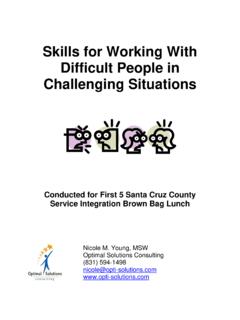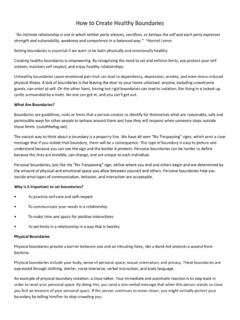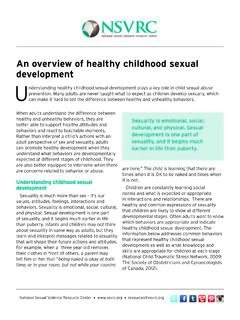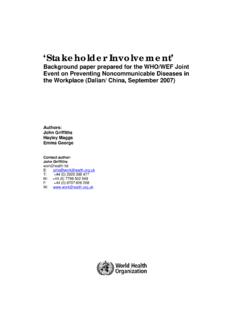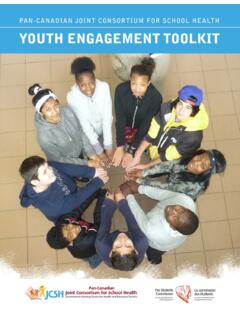Transcription of Maintaining Professional Boundaries in Interpersonal Work
1 Maintaining Professional Boundaries in Interpersonal work Conducted for: First 5 Santa Cruz County Service Integration Brown Bag Lunches August 2008. Presenters: August 4: Kelly Wolf, Program Manager CASA of Santa Cruz County August 8: Francis Krebs, Supervisor Health Services Agency, Children's Mental Health Agenda I. Welcome & Introductions II. Defining personal Boundaries III. Small group discussions a. Why are Professional Boundaries important in our work ? b. What are some potential consequences of a service provider having loose or poor Professional Boundaries ? c. What are some factors that could make it hard to create and maintain Professional Boundaries ?
2 IV. Report back to big group V. Small-group work on scenarios VI. Report back to large group; brainstorms techniques for creating & Maintaining Boundaries VII. Closing comments & evaluations Prepared by Kelly Wolf, CASA of Santa Cruz County 2 July 2008. Source: Professional Boundaries : A Nurse's Guide to the Importance of Professional Boundaries , Prepared by Kelly Wolf, CASA of Santa Cruz County 3 July 2008. What Are Professional Boundaries ? Clearly established limits that allow for safe connections between service providers and their clients Being with the client, not becoming the client Being friendly, not friends The ability to know where you end and the client begins A clear understanding of the limits and responsibilities of your role as a service provider Prepared by Kelly Wolf, CASA of Santa Cruz County 4 July 2008.
3 The Importance of Boundaries Role modeling to the client healthy communication and Professional relationships Avoiding the rescuer role Staying focused on one's responsibilities to the client & the provision of helpful and appropriate services to the client Avoiding burn-out ( compassion fatigue ). If working in conjunction with other services providers: Maintaining a healthy, open, communicating and functioning team Maintaining one's physical and emotional safety Prepared by Kelly Wolf, CASA of Santa Cruz County 5 July 2008. Consequences of Having Loose/Poor Boundaries Compassion fatigue the service provider's role may not feel sustainable Potential for splitting on teams Client may not be given appropriate or helpful services, which could affect his/her willingness to accept future services Client may feel betrayed, abandoned, and/or poorly served Service provider may act unethically The reputation of the service provider's agency and/or profession may be compromised Service provider and/or client may be emotionally traumatized and/or put in physical danger Prepared by Kelly Wolf, CASA of Santa Cruz County 6 July 2008.
4 Why Is It Difficult to Establish and Maintain Professional Boundaries ? Dual relationships The service provider & client know each other in a personal context from another setting. Values conflicts The client's choices, history, relationships, feelings, lifestyle and/or life circumstances conflict with the service provider's values and/or knowledge about best practices. Vicarious trauma The service provider experiences trauma symptoms from hearing about the client's experiences. The service provider may be triggered due to having a history of similar circumstances. Playing the hero role The service provider feels the need to save the client.
5 Poor teamwork The service provider does not trust that other team members are fulfilling their responsibilities to the client, believes that he/she can provide their services better than they can, and/or believes that the client works best only with him/her. The service provider takes over the roles of the other team members. Prepared by Kelly Wolf, CASA of Santa Cruz County 7 July 2008. Signs that Boundary Issues May Be Present Between Service Provider and Client Client and service provider begin referring to each other as friends Service provider receives gifts from or gives gifts to client Client has or is asking for service provider's home phone number or other significant personal information Client asks/expects service provider to socialize with him/her outside of Professional setting ( , client asks service provider to begin attending church with his/her family).
6 Service provider reveals excessive personal information to client Service provider is unable to sleep due to anxiety related to client/client's situation Discussion regarding work /clients dominates service provider's social interactions with friends & family Service provider offers to provide assistance to client outside of his/her role ( , babysitting; transportation). Service provider finds him/herself venting with client about other service providers on team Prepared by Kelly Wolf, CASA of Santa Cruz County 8 July 2008. Techniques for Creating & Maintaining Healthy Professional Boundaries As early as possible in the relationship (ideally at your initial meeting/intake/ assessment), establish clear agreements with the client regarding your role as a service provider, your availability, best ways to communicate with you, and what to do if you see one another in public.
7 When boundary issues or warning signs appear, address these issues with the client quickly. Be sensitive to their feelings when doing this; emphasize the importance of and your commitment to Maintaining healthy Boundaries . Self-disclosure: if you do decide to tell a client something personal about yourself, ensure that the information is related to the client's goals. Too much self-disclosure shifts the focus from the client to the service provider and can confuse the client in terms of roles and expectations of the relationship. Realize that how a client interprets your words and actions might not match what you were trying to communicate.
8 With these sensitive relationships, you may need to frequently clarify your role and Boundaries and ask the client to repeat back what you said to ensure that he/she understands. This will also give the client an opportunity to ask clarifying questions. Use your supervisor, Professional colleagues and/or a mental health Professional as a sounding board when you have questions or concerns regarding Boundaries , and especially when boundary issues are impacting your ability to provide objective, compassionate care. Also consult with your supervisor or Professional colleagues if you are feeling uncomfortable about talking with your clients about Boundaries .
9 Prepared by Kelly Wolf, CASA of Santa Cruz County 9 July 2008. Dual relationships: If you had a personal relationship with a client before becoming the client's service provider, realize that you must use your Professional judgment when interacting with the client in social settings. Pay particular attention to the client's confidentiality as well as his/her physical and emotional security. Situations in which one person is in a position to hold power over the other person must be avoided if at all possible. For supervisors: Recognize that questioning someone's Boundaries can create defensiveness. Rather than instructing someone to have better Boundaries , use open-ended questions to help the service provider identify for him/herself that his/her work would benefit from the establishment of clearer Boundaries .
10 If you are working with a team of service providers, remember to promote and role model positive, open communication and respectful sharing of information. Trust that team members are fulfilling their roles as service providers, and remember that you can't (and shouldn't) do and be everything for your client. Take care of yourself! Make sure you are getting enough sleep, eating well, spending time with friends and family, exercising, seeking supervision as needed, and leaving work at work to the greatest extent possible. For more information: Offers a variety of seminars, online courses, and telephonic courses (providing CME, CE, or CEU credits) for physicians, nurses, social workers, and other health professionals.
